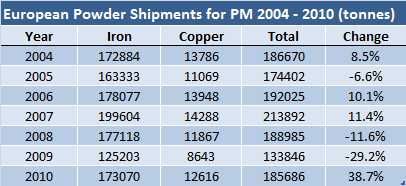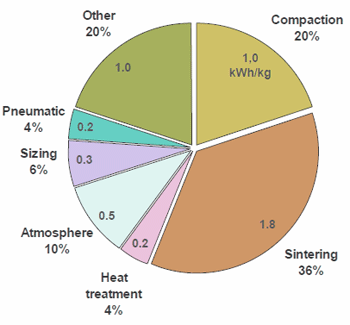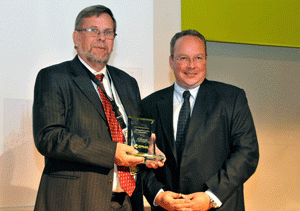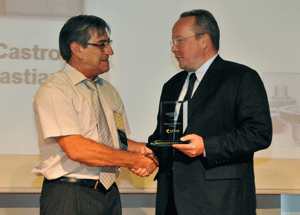Euro PM2011 – Barcelona attracts the largest Powder Metallurgy audience of the year
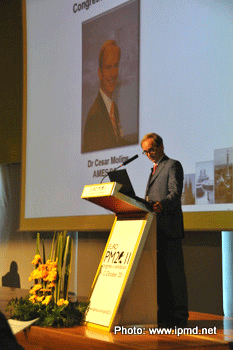
Dr Cesar Molins (Director General of the
AMES Group) welcomed some 900
delegates from around the world
The conference co-chairmen, Dr Cesar Molins (Director General of the AMES Group) and Professor Francisco Castro (CEIT), welcomed some 900 delegates from nearly 50 countries around the world to the Euro PM2011 conference and exhibition at the CCIB Congress Centre, Barcelona, Spain, October 10-12.
Organised by the European Powder Metallurgy Association (EPMA), the conference included over 250 technical presentations covering all aspects of Powder Metallurgy in four parallel session, plus special interest seminars on ‘Functional Surfaces in Hard Materials’, ‘Metal Injection Moulding of Applied Functional Materials’, and ‘PM Biomaterials’. The event also included a sell out exhibition with 90 stands covering companies from all parts of the PM supply chain.
Jonathan Wroe, EPMA Executive Director said “Barcelona has proved a most popular location for what has been the largest PM event in the world this year and the largest Euro PM event we have ever organised. We would like to thank the efforts of the EPMA Spanish Chapter and the Generalitat de Catalunya, plus the support of our members and delegates, which is much appreciated”.
During the plenary session at EuroPM 2011, EPMA President Ingo Cremer reviewed developments in the European PM industry up to and including 2011. He stated that the ‘real’ economy was not following the downward trends in the world’s stockmarkets, and that PM production in 2011 was holding up well after the strong recovery in 2010.
European powder shipments for iron and copper powders had increased by 38.7% to reach a combined total of 185,686 tonnes, he said, although this was still some way off the record total of 213,892 tonnes achieved in 2007 (see Table). Cremer stated that metal injection moulding sales in Europe had reached €165 million in 2010 and that PM high alloy steel production now exceeded 4,500 tonnes. Hardmetal production remained the single largest PM segment in Europe in terms of sales, he added.
However, whilst the European PM industry appeared to be over the worst after the recession of 2008/2009, Cremer was at the same time cautious about the future. In particular he was concerned about the unpredictability of raw materials prices, the continuing rise in oil and energy prices, and inflation which stood at 2.5% in the Eurozone.
He pointed to the continuing growth phenomenon in China where he stated PM part and PM bearing production had risen by nearly 43% in 2010 to over 137,000 tonnes. With an estimated 50% of PM parts demand still being met by imports, there was still considerable scope for the Chinese PM industry to increase output still further, said Cremer. China produced 18.3 million vehicles in 2010 of which 14 million were cars – the highest total of any country.
PM best in class for energy consumption
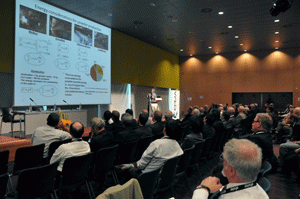
Dr Volker Arnhold, Vice President – Global Advanced
Engineering, GKN Sinter Metals GmbH, during his
keynote presentation (courtesy EPMA)
In his keynote address during the Euro PM2011 plenary session, Dr Volker Arnhold, Vice President – Global Advanced Engineering at GKN Sinter Metals GmbH (Radevormwald, Germany), gave an interesting and useful analysis of the energy consumption in iron powder and PM part production, and benchmarking this with competitive metal forming processes such as casting, forging and machining.
The presentation, which was co-authored by Dr Vladislav Kruzhanov (Director, R&D Europe, GKN Sinter Metals), showed that PM technology is indeed the most energy efficient among the various metal forming processes in terms of kWh/tonne of components produced. However, there was nevertheless a constant need to reduce energy requirement in the PM process in order to combat rising energy costs, to eliminate waste energy, and to meet stricter EU regulations on CO2 emissions in the manufacturing environment
Dr Arnhold stated that energy consumption in the production of water atomized iron powder using scrap metal was approx. 2 kWh/kg and this compared favourably with crude steel production which consumes 5 kWh/kg. Sponge iron powder was a little higher per kg at approx 4 kWh.
Dr Arnhold stated that in conventional PM part production an average total of 5 kWh/kg energy is consumed but with heavier, large size PM parts requiring considerably less energy per kg than smaller sized PM parts. As would be expected the highest amount of energy consumed in the PM process is for sintering and sintering atmospheres which combined make up nearly 50% of the energy needed.
Dr Arnhold said that there was still scope to improve the ‘productive’ heat in a sintering furnace which currently stands at only 30% of the energy used. The remaining energy is dissipated from the furnace. Recuperation of some of this ‘unproductive’ energy in the furnace should reduce the energy requirement in sintering significantly. A breakdown of the typical energy consumption in PM production is shown in the pie chart.
EPMA 2011 Distinguished Service Awards presented in Barcelona
Delegates attending the plenary session of Euro PM 2011 in Barcelona saw EPMA President Mr Ingo Cremer present the EPMA Distinguished Service Awards for 2011 to Dr Olle Grinder founder of PM Technology, Sweden, and Professor Francisco Castro of CEIT, San Sebastian, Spain. The two men are both very well known in the global PM community and between them have amassed over 350 technical reports and papers.
Dr Grinder studied at the Royal Institute of Technology before moving to the Axel Johnson Institute for Industrial Research and then in 1977 to the Swedish Institute for Metals Research (now Swerea KIMAB) in Stockholm. Since 1986, he has been employed part time as a lecturer at the Royal Institute of Technology, but has worked mainly in his own company, PM Technology, on business development and consultation to companies internationally. Furthermore, he has established an international organization “Global PM Consultants” with three colleagues who work on various PM projects.
Professor Castro, originally from Mexico, studied for his Doctorate at Sheffield University and has worked at CEIT since 1985 where as head of the ‘Consolidation of Metallic and Ceramic Powders Area’ at he has built up a research group of 36 people, one of the largest PM groups in Europe. As part of his scientific activities he has supervised a number of Masters theses, and no less than 23 PhD theses, one of which merited the Schunk Prize for Outstanding Developments in Powder Metallurgy. In addition to his role at CEIT, Professor Castro teaches Materials Science at Tecnun, the School of Engineering at the University of Navarra.
> > > See our photo gallery of Euro PM2011
News | Articles | Market reviews | Search directory | Subscribe to e-newsletter



